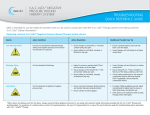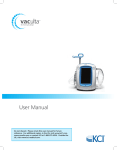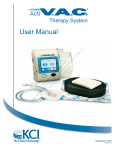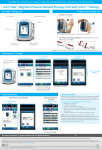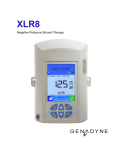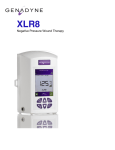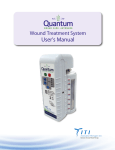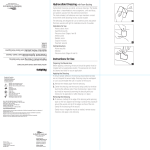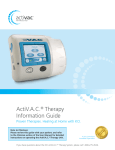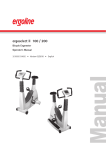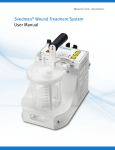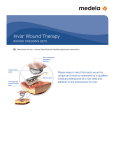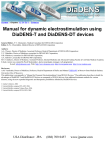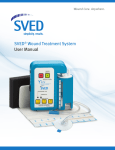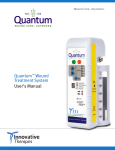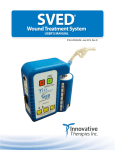Download V.A.C.UltA™ NegAtiVe PressUre WoUNd therAPy system (V.A.C.
Transcript
V.A.C.Ulta™ Negative Pressure Wound Therapy System (V.A.C.Ulta™ Therapy System) Safety Information and V.A.C. VeRAFLO Cleanse™ Dressing System Application Instructions Only for use with the KCI V.A.C.Ulta™ Therapy System Table of Contents Indications for Use...................................................................................................................... 2 Transitioning V.A.C.® Therapy Into Home Care............................................................................ 3 V.A.C.Ulta™ Therapy System Contraindications.......................................................................... 3 Additional Contraindications Specific to V.A.C. VeraFlo™ Therapy.............................................. 3 V.A.C.Ulta™ Therapy System Warnings....................................................................................... 4 Additional Warnings for V.A.C. VeraFlo™ Therapy...................................................................... 8 V.A.C.Ulta™ Therapy System Precautions.................................................................................... 8 Additional Precautions for V.A.C. VeraFlo™ Therapy................................................................... 10 Additional Precautions for V.A.C. GranuFoam Silver® Dressing..................................................... 11 V.A.C. VeraFlo Cleanse™ Dressing System Application Instructions.............................................. 12 Dressing Description................................................................................................................... 12 V.A.C. VeraFlo Cleanse™ Dressing System Component Identification.......................................... 14 Accessories needed for V.A.C. VeraFlo™ Therapy with the V.A.C.Ulta™ Therapy System (provided separately)................................................................................................................... 14 Dressing Changes....................................................................................................................... 15 Wound Preparation..................................................................................................................... 15 V.A.C. VeraFlo Cleanse™ Dressing Application............................................................................ 17 V.A.C.® Advanced Drape Application........................................................................................... 19 V.A.C. VeraT.R.A.C.™ Pad Application........................................................................................ 20 V.A.C. VeraT.R.A.C. Duo™ Tube Set Application.......................................................................... 21 Instill Pad Application.................................................................................................................. 21 SensaT.R.A.C.™ Pad Application................................................................................................. 22 Initiate V.A.C. VeraFlo™ Therapy................................................................................................. 23 Bridge Away From The Wound.................................................................................................... 25 Using V.A.C. VeraFlo Cleanse™ Dressing..................................................................................... 25 Using V.A.C. VeraFlo™ Dressing in Conjunction with Bandages, Garments, or Off-Loading Devices.............................................................................. 27 Explanation of Symbols Used in Disposables Labeling.................................................................. 29 3 The V.A.C.Ulta™ Negative Pressure Wound Therapy System (V.A.C.Ulta™ Therapy System) is an integrated wound therapy system that can deliver either: • V.A.C. VeraFlo™ Therapy (Instillation), which consists of negative pressure wound therapy (V.A.C.® Therapy) coupled with controlled delivery and drainage of topical wound irrigation treatment solutions and suspensions over the wound bed. OR • V.A.C.® Therapy, which consists of negative pressure wound therapy alone. When using V.A.C. VeraFlo™ Therapy (Instillation), there are important Contraindications, Warnings, and Precautions that should be considered in addition to the Contraindications, Warnings and Precautions for V.A.C.® Therapy. Contraindications, Warnings and Precautions specific to V.A.C. VeraFlo™ Therapy are highlighted in grey throughout the document and are identified by the V.A.C. VeraFlo™ Therapy symbol to the left of the text. When using V.A.C.® Therapy alone, the V.A.C. VeraFlo™ Therapy Contraindications, Warnings and Precautions are not applicable. The V.A.C.Ulta™ Therapy Unit is for use only with V.A.C.® Dressings (V.A.C.® GranuFoam™, V.A.C. GranuFoam Silver®, V.A.C.® WhiteFoam, V.A.C. VeraFlo™ and V.A.C. VeraFlo Cleanse™ Dressing Systems) and disposables. V.A.C. VeraFlo™ Therapy should only be delivered with V.A.C. VeraFlo™ Dressings and disposables. NOTE: The V.A.C. GranuFoam Silver® Dressing is not intended to be used with V.A.C. VeraFlo™ Therapy because instillation solutions may negatively impact the benefits of the V.A.C. GranuFoam Silver® Dressing. IMPORTANT: As with any prescription medical device, failure to consult a physician and carefully read and follow all therapy unit and dressing instructions and safety information prior to each use may lead to improper product performance and the potential for serious or fatal injury. Do not adjust therapy unit settings or perform therapy application without directions from / or supervision by the clinical caregiver. Indications for Use The V.A.C.Ulta™ Negative Pressure Wound Therapy System is an integrated wound management system that provides Negative Pressure Wound Therapy with an instillation option. Negative Pressure Wound Therapy in the absense of instillation is intended to create an environment that promotes wound healing by secondary or tertiary (delayed primary) intention by preparing the wound bed for closure, reducing edema, promoting granulation tissue formation and perfusion, and by removing exudate and infectious material. The instillation option is indicated for patients who would benefit from vacuum assisted drainage and controlled delivery of topical wound treatment solutions and suspensions over the wound bed. The V.A.C.Ulta™ Negative Pressure Wound Therapy System with and without instillation is indicated for patients with chronic, acute, traumatic, sub-acute and dehisced wounds, partialthickness burns, ulcers (such as diabetic, pressure and venous insufficiency), flaps and grafts. 4 Transitioning V.A.C.® Therapy Into Home Care The V.A.C.Ulta™ Therapy System is not intended for home use. If there is a need to continue V.A.C.® Therapy when a patient transitions home, consider using other KCI Therapy Systems approved for the post-acute care environment. Refer to the safety information included with those devices for important information. V.A.C.Ulta™ Therapy System Contraindications • Do not place foam dressings of the V.A.C.Ulta™ Therapy System (including both V.A.C.® Therapy and V.A.C. VeraFlo™ Therapy Dressings) directly in contact with exposed blood vessels, anastomotic sites, organs or nerves. NOTE: Refer to Warnings section for additional information concerning Bleeding. • V.A.C.® Therapy and V.A.C. VeraFlo™ Therapy are contraindicated for patients with: • Malignancy in the wound • Untreated osteomyelitis NOTE: Refer to Warnings section for Osteomyelitis information. • Non-enteric and unexplored fistulas • Necrotic tissue with eschar present NOTE: After debridement of necrotic tissue and complete removal of eschar, V.A.C.® Therapy may be used. • Sensitivity to silver (V.A.C. GranuFoam Silver® Dressing only) Additional Contraindications Specific to V.A.C. VeraFlo™ Therapy • Do not use V.A.C.® Dressings with Octenisept®*, hydrogen peroxide or solutions that are alcohol-based or contain alcohol. • Do not deliver fluids to the thoracic or abdominal cavity due to the potential risk to alter core body temperature and the potential for fluid retention within the cavity. • Do not use V.A.C. VeraFlo™ Therapy unless the wound has been throughly explored due to the potential for inadvertent instillation of topical wound solutions to adjacent body cavities. *Not available in the United States. Brand name referenced is not a trademark of KCI, its affiliates, or licensors. 5 V.A.C.Ulta™ Therapy System Warnings Bleeding: With or without using V.A.C.® Therapy or V.A.C. VeraFlo™ Therapy, certain patients are at high risk of bleeding complications. The following types of patients are at increased risk of bleeding, which, if uncontrolled, could be potentially fatal. • Patients who have weakened or friable blood vessels or organs in or around the wound as a result of, but not limited to: • Suturing of the blood vessel (native anastamoses or grafts) / organ • Infection • Trauma • Radiation • Patients without adequate wound hemostasis • Patients who have been administered anticoagulants or platelet aggregation inhibitors • Patients who do not have adequate tissue coverage over vascular structures. If V.A.C.® Therapy or V.A.C. VeraFlo™ Therapy is prescribed for patients who have an increased risk of bleeding complications, they should be treated and monitored in a care setting deemed appropriate by the treating physician. If active bleeding develops suddenly or in large amounts during V.A.C.® Therapy or V.A.C. VeraFlo™ Therapy, or if frank (bright red) blood is seen in the tubing or in the canister, immediately stop therapy, leave dressing in place, take measures to stop the bleeding, and seek immediate medical assistance. The V.A.C.Ulta™ Therapy Unit and dressings (both V.A.C.® Therapy and V.A.C. VeraFlo™ Therapy) should not be used to prevent, minimize or stop vascular bleeding. • Protect Vessels and Organs: All exposed or superficial vessels and organs in or around the wound must be completely covered and protected prior to the administration of V.A.C.® Therapy or V.A.C. VeraFlo™ Therapy. Always ensure that V.A.C.® Foam Dressings and V.A.C. VeraFlo™ Foam Dressings do not come in direct contact with vessels or organs. Use of a thick layer of natural tissue should provide the most effective protection. If a thick layer of natural tissue is not available or is not surgically possible, multiple layers of fine-meshed, non-adherent material may be considered as an alternative, if deemed by the treating physician to provide a complete protective barrier. If using non-adherent materials, ensure that they are secured in a manner as to maintain their protective position throughout therapy. Consideration should also be given to the negative pressure setting and therapy mode used when initiating therapy. Caution should be taken when treating large wounds that may contain hidden vessels, which may not be readily apparent. The patient should be closely monitored for bleeding in a care setting deemed appropriate by the treating physician. 6 • Infected Blood Vessels: Infection may erode blood vessels and weaken the vascular wall which may increase susceptibility to vessel damage through abrasion or manipulation. Infected blood vessels are at risk of complications, including bleeding, which, if uncontrolled, could be potentially fatal. Extreme caution should be used when V.A.C.® Therapy or V.A.C. VeraFlo™ Therapy is applied in close proximity to infected or potentially infected blood vessels. (Refer to Protect Vessels and Organs section.) • Hemostasis, Anticoagulants and Platelet Aggregation Inhibitors: Patients without adequate wound hemostasis have an increased risk of bleeding, which, if uncontrolled, could be potentially fatal. These patients should be treated and monitored in a care setting deemed appropriate by the treating physician. Caution should be used in treating patients on doses of anticoagulants or platelet aggregation inhibitors thought to increase their risk for bleeding (relative to the type and complexity of the wound). Consideration should be given to the negative pressure setting and therapy mode used when initiating therapy. • Hemostatic Agents Applied at the Wound Site: Non-sutured hemostatic agents (for example, bone wax, absorbable gelatin sponge or spray wound sealant) may, if disrupted, increase the risk of bleeding, which, if uncontrolled, could be potentially fatal. Protect against dislodging such agents. Consideration should be given to the negative pressure setting and therapy mode used when initiating therapy. (Refer to Additional Warnings for V.A.C. VeraFlo™ Therapy section). • Sharp Edges: Bone fragments or sharp edges could puncture protective barriers, vessels or organs causing injury. Any injury could cause bleeding, which, if uncontrolled, could be potentially fatal. Beware of possible shifting in the relative position of tissues, vessels or organs within the wound that might increase the possibility of contact with sharp edges. Sharp edges or bone fragments must be eliminated from the wound area or covered to prevent them from puncturing blood vessels or organs before the application of V.A.C.® Therapy or V.A.C. VeraFlo™ Therapy. Where possible, completely smooth and cover any residual edges to decrease the risk of serious or fatal injury, should shifting of structures occur. Use caution when removing dressing components from the wound so that wound tissue is not damaged by unprotected sharp edges. 1000 mL Canister: DO NOT USE the 1000 mL canister on patients with a high risk of bleeding or on patients unable to tolerate a large loss of fluid volume, including children and the elderly. Consider the size and weight of the patient, patient condition, wound type, monitoring capability and care setting when using this canister. This canister is recommended for acute care (hospital) use only. 7 Infected Wounds: Infected wounds should be monitored closely and may require more frequent dressing changes than non-infected wounds, dependent upon factors such as wound conditions, treatment goals and V.A.C. VeraFlo™ Therapy parameters (for the V.A.C.Ulta™ Therapy System). Refer to dressing application instructions (found in V.A.C.® Dressing and V.A.C. VeraFlo™ Dressing cartons) for details regarding dressing change frequency. As with any wound treatment, clinicians and patients / caregivers should frequently monitor the patient’s wound, periwound tissue and exudate for signs of infection, worsening infection or other complications. Some signs of infection are fever, tenderness, redness, swelling, itching, rash, increased warmth in the wound or periwound area, purulent discharge or strong odor. Infection can be serious, and can lead to complications such as pain, discomfort, fever, gangrene, toxic shock, septic shock and / or fatal injury. Some signs or complications of systemic infection are nausea, vomiting, diarrhea, headache, dizziness, fainting, sore throat with swelling of the mucus membranes, disorientation, high fever, refractory and / or orthostatic hypotension, or erythroderma (a sunburn-like rash). If there are any signs of the onset of systemic infection or advancing infection at the wound site, contact a physician immediately to determine if V.A.C.® Therapy or V.A.C. VeraFlo™ Therapy should be discontinued. For wound infections relating to blood vessels, please also refer to the section titled Infected Blood Vessels. Infected Wounds with V.A.C. GranuFoam Silver® Dressing: In the event of clinical infection, V.A.C. GranuFoam Silver® Dressing is not intended to replace the use of systemic therapy or other infection treatment regimens. V.A.C. GranuFoam Silver® Dressing may be used to provide a barrier to bacterial penetration. Refer to the section titled Additional Precautions for V.A.C. GranuFoam Silver® Dressing. Osteomyelitis: V.A.C.® Therapy and V.A.C. VeraFlo™ Therapy should NOT be initiated on a wound with untreated osteomyelitis. Consideration should be given to thorough debridement of all necrotic, non-viable tissue, including infected bone (if necessary), and appropriate antibiotic therapy. Protect Tendons, Ligaments and Nerves: Tendons, ligaments and nerves should be protected to avoid direct contact with V.A.C.® Foam Dressings or V.A.C. VeraFlo™ Therapy Foam Dressings. These structures may be covered with natural tissue or meshed non-adherent material to help minimize risk of desiccation or injury. Foam Placement: Always use V.A.C.® Dressings or V.A.C. VeraFlo™ Therapy Dressings from sterile packages that have not been opened or damaged. Do not place any foam dressing into blind / unexplored tunnels. The V.A.C.® WhiteFoam Dressing may be more appropriate for use with explored tunnels. The V.A.C. VeraFlo Cleanse™ Dressing System may be more appropriate for use with explored tunnels when using V.A.C. VeraFlo™ Therapy where robust granulation tissue formation is not desired. Do not force foam dressings into any area of the wound, as this may damage tissue, alter the delivery of negative pressure, or hinder exudate and foam removal. Always count the total number of pieces of foam used in the wound and the dressing change date and document that number on the drape, in the patient’s chart and on the foam quantity label attached to the pad tubing (if provided). 8 Foam Removal: V.A.C.® Foam Dressings and V.A.C. VeraFlo™ Therapy Foam Dressings are not bioabsorbable. Always count the total number of pieces of foam removed from the wound and ensure the same number of foam pieces was removed as placed. Foam left in the wound for greater than the recommended time period may foster ingrowth of tissue into the foam, create difficulty in removing foam from the wound, or lead to infection or other adverse events. If significant bleeding develops, immediately discontinue the use of the V.A.C.Ulta™ Therapy System, take measures to stop the bleeding, and do not remove the foam dressing until the treating physician or surgeon is consulted. Do not resume the use of the V.A.C.® Therapy or V.A.C. VeraFlo™ Therapy until adequate hemostasis has been achieved and the patient is not at risk for continued bleeding. Keep V.A.C.® Therapy and V.A.C. VeraFlo™ Therapy On: Never leave a V.A.C.® Dressing or V.A.C. VeraFlo™ Therapy Dressing in place without active V.A.C.® Therapy or V.A.C. VeraFlo™ Therapy for more than two hours. If therapy is off for more than two hours, remove the old dressing and irrigate the wound. Either apply a new V.A.C.® Dressing or V.A.C. VeraFlo™ Therapy Dressing from an unopened sterile package and restart therapy; or apply an alternative dressing at the direction of the treating clinician. Acrylic Adhesive: The V.A.C.® Drape (supplied with V.A.C.® Dressings) and the V.A.C.® Advanced Drape (supplied with V.A.C. VeraFlo™ Therapy Dressings) have an acrylic adhesive coating, which may present a risk of an adverse reaction in patients who are allergic or hypersensitive to acrylic adhesives. If a patient has a known allergy or hypersensitivity to such adhesives, do not use the V.A.C.Ulta™ Therapy System. If any signs of allergic reaction or hypersensitivity develop, such as redness, swelling, rash, urticaria or significant pruritus, discontinue use and consult a physician immediately. If bronchospasm or more serious signs of allergic reaction appear, seek immediate medical assistance. Defibrillation: Remove the V.A.C.® Dressing or V.A.C. VeraFlo™ Therapy Dressing if defibrillation is required in the area of dressing placement. Failure to remove the dressing may inhibit transmission of electrical energy and / or patient resuscitation. Magnetic Resonance Imaging (MRI) – Therapy Unit: The V.A.C.Ulta™ Therapy Unit is MR Unsafe. Do not take the V.A.C.Ulta™ Therapy Unit into the MR environment. Magnetic Resonance Imaging (MRI) – V.A.C.® Dressings: V.A.C.® Dressings and V.A.C. VeraFlo™ Therapy Dressings can typically remain on the patient with minimal risk in an MR environment, assuming that use of the V.A.C.Ulta™ Therapy System is not interrupted for more than two hours (refer to Keep V.A.C.® Therapy and V.A.C. VeraFlo™ Therapy On above). NOTE: If using V.A.C. VeraFlo™ Therapy ensure that irrigation fluid or treatment solutions are fully removed from the dressing prior to stopping negative pressure wound therapy. The V.A.C. GranuFoam Silver® Dressing has been shown to pose no known hazards in an MR environment with the following conditions of use: • Static magnetic field of 3 Tesla or less, • Spatial gradient field of 720 Gauss / cm or less, and • Maximum whole-body-averaged specific absorption rate (SAR) of 3 W / kg for 15 minutes of scanning 9 Non-clinical testing under these same conditions produced a temperature rise of <0.4°C. MR image quality may be compromised if the area of interest is in the same area or relatively close to the position of the V.A.C. GranuFoam Silver® Dressing. Hyperbaric Oxygen Therapy (HBO): Do not take the V.A.C.Ulta™ Therapy Unit into a hyperbaric oxygen chamber. The V.A.C.Ulta™ Therapy Unit is not designed for this environment and should be considered a fire hazard. After disconnecting the V.A.C.Ulta™ Therapy Unit, either (i) replace the V.A.C.® Dressing or V.A.C. VeraFlo™ Therapy Dressing with another HBO compatible material during the hyperbaric treatment, or (ii) cover the unclamped end of the V.A.C.® Tubing with moist cotton gauze and completely cover the V.A.C.® Dressing or V.A.C. VeraFlo™ Therapy Dressing (including tubing) with a moist towel throughout the treatment in the chamber. For HBO therapy, the V.A.C.® Tubing or V.A.C. VeraFlo™ Therapy Tubing must not be clamped. Never leave a V.A.C.® Dressing in place without active V.A.C.® Therapy for more than two hours; please refer to the Keep V.A.C.® Therapy On section. NOTE: If using V.A.C. VeraFlo™ Therapy ensure that irrigation fluid or treatment solutions are fully removed from the dressing prior to stopping negative pressure wound therapy. Additional Warnings for V.A.C. VeraFlo™ Therapy Topical Wound Solutions: Topical wound solutions or suspensions may enter internal body cavities if the wound is open to such cavities. They should not be infused into wounds with unexplored tunnels or unexplored undermining as they may enter into unintended cavities. Pauses in Negative Pressure: Application of V.A.C. VeraFlo™ Therapy will result in pauses of negative pressure wound therapy, which is not recommended on wounds requiring continuous V.A.C.® Therapy. Do not use V.A.C. VeraFlo™ Therapy over unstable structures, such as unstable chest wall or non-intact fascia, on patients at increased risk of bleeding, highly exudating wounds, on flaps, grafts or wounds with acute enteric fistulae. Bioengineered Tissue: V.A.C. VeraFlo™ Therapy is not intended for use with cellular or accellular bioengineered tissues. Hemostasis: Patients with difficult or fragile wound hemostasis are at increased risk of bleeding associated with V.A.C. VeraFlo™ Therapy due to the potential for disruption of clots or dilution of clotting factors. Do not use V.A.C. VeraFlo™ Therapy where hemostatic agents have been used in the wound bed. V.A.C.Ulta™ Therapy System Precautions Standard Precautions: To reduce the risk of transmission of bloodborne pathogens, apply standard precautions for infection control with all patients, per institutional protocol, regardless of their diagnosis or presumed infection status. In addition to gloves, use gown and goggles if exposure to body fluids is likely. 10 Continuous Versus DPC (Dynamic Pressure Control) V.A.C.® Therapy: Continuous V.A.C.® Therapy is recommended over unstable structures, such as an unstable chest wall or non-intact fascia, in order to help minimize movement and stabilize the wound bed. Continuous therapy is also generally recommended for patients at increased risk of bleeding, highly exudating wounds, fresh flaps and grafts, and wounds with acute enteric fistulae. NOTE: V.A.C. VeraFlo™ Therapy, due to the controlled delivery of wound irrigation and treatment solutions, provides intermittent V.A.C.® Therapy and is not recommended in the above wound types or conditions. Patient Size and Weight: The size and weight of the patient should be considered when prescribing V.A.C.® Therapy or V.A.C. VeraFlo™ Therapy. Infants, children, certain small adults and elderly patients should be closely monitored for fluid loss and dehydration. Also, patients with highly exudating wounds or large wounds in relation to the patient size and weight should be closely monitored, as they have a risk of excessive fluid loss and dehydration. When monitoring fluid output, consider the volume of fluid in both the tubing and canister. Spinal Cord Injury (SCI): In the event an SCI patient experiences autonomic dysreflexia (sudden changes in blood pressure or heart rate in response to stimulation of the sympathetic nervous system), discontinue V.A.C.® Therapy or V.A.C. VeraFlo™ Therapy to help minimize sensory stimulation and seek immediate medical assistance. Bradycardia: To minimize the risk of bradycardia, V.A.C.® Therapy and V.A.C. VeraFlo™ Therapy must not be placed in proximity to the vagus nerve. Enteric Fistulas: Wounds with enteric fistulas require special precautions to optimize V.A.C.® Therapy. Refer to V.A.C.® Therapy Clinical Guidelines for more detail. V.A.C.® Therapy is not recommended if enteric fistula effluent management or containment is the sole goal of therapy. NOTE: V.A.C. VeraFlo™ Therapy should not be used in the presence of enteric fistula to prevent wound contamination. Protect Periwound Skin: Consider use of a skin preparation product to protect periwound skin. Do not allow foam to overlap onto intact skin. Protect fragile / friable periwound skin with additional V.A.C.® Advanced Drape, skin protectant, hydrocolloid or other transparent film. Multiple layers of the V.A.C.® Advanced Drape may decrease the moisture vapor transmission rate, which may increase the risk of maceration. If any signs of irritation or sensitivity to the drape, foam or tubing assembly appear, discontinue use and consult treating physician. To avoid trauma to the periwound skin, do not pull or stretch the drape over the foam dressing during drape application. Extra caution should be used for patients with neuropathic etiologies or circulatory compromise. Circumferential Dressing Application: Avoid use of circumferential dressings except in the presence of anasarca or excessively weeping extremities, where a circumferential drape technique may be necessary to establish and maintain a seal. Consider using multiple small pieces of V.A.C.® Advanced Drape rather than one continuous piece to minimize the risk of decreased distal circulation. Extreme care should be taken not to stretch or pull the drape when securing it, but let it attach loosely and stabilize the edges with an elastic wrap, if necessary. When using circumferential drape applications, it is crucial to systematically and recurrently palpate distal pulses, and assess distal circulatory status. If circulatory compromise is suspected, discontinue therapy, remove dressing and contact treating physician. 11 Pressure Points: Periodically assess and monitor the location of tubing connectors, caps, clamps or other rigid components to ensure they do not create inadvertent pressure points in relation to patient position. V.A.C.Ulta™ Therapy Unit Pressure Excursions: In rare instances, tubing blockages with the V.A.C.Ulta™ Therapy Unit may result in brief vacuum excursions to more than 250 mmHg negative pressure. Resolve alarm conditions immediately. Refer to the V.A.C.Ulta™ Therapy System User Manual or contact your KCI representative for additional information. Additional Precautions for V.A.C. VeraFlo™ Therapy Suitable Solutions: V.A.C. VeraFlo™ Therapy is intended for use with V.A.C. VeraFlo™ Therapy disposables and topical wound treatment solutions and suspensions. Only use solutions or suspensions that are: • Indicated for topical wound treatment according to solution manufacturer’s instructions for use. Some topical agents may not be intended for extended tissue contact. If in doubt about the appropriateness of using a particular solution for V.A.C. VeraFlo™ Therapy, contact the solution’s manufacturer about its suitability for saturated topical wound exposure. • Compatible with V.A.C.® Dressings and disposable components. Contact your KCI representative for a list of solutions shown to be compatible with V.A.C.® Dressings and disposable components. NOTE: Hypochlorous acid solutions applied frequently at high concentrations can lead to significant material degradation. Consider utilizing concentrations and exposure durations as low as clinically relevant. NOTE: The V.A.C. GranuFoam Silver® Dressing is not intended to be used with V.A.C. VeraFlo™ Therapy because instillation solutions may negatively impact the benefits of the V.A.C. GranuFoam Silver® Dressing. Canister Changes: Monitor fluid level in canisters frequently during use of the V.A.C. VeraFlo™ Therapy. Frequent canister changes may be necessary depending on volume of fluid instilled and wound exudates. At a minimum the canister should be changed weekly and disposed of according to institutional protocol. 12 Additional Precautions for V.A.C. GranuFoam Silver® Dressing Topical Solutions or Agents: The V.A.C. GranuFoam Silver® Dressing is not intended to be used with V.A.C. VeraFlo™ Therapy because instillation solutions may negatively impact the benefits of the V.A.C. GranuFoam Silver® Dressing. Protective Layer: As with all V.A.C.® Foam Dressings, the V.A.C. GranuFoam Silver® Dressing should not be placed in direct contact with exposed blood vessels, anastomotic sites, organs or nerves (refer to section on Protect Vessels and Organs). Intervening non-adherent layers may be placed between the V.A.C. GranuFoam Silver® Dressing and the wound surface; however, these products may compromise the effectiveness of the V.A.C. GranuFoam Silver® Dressing in the area covered by the non-adherent layer. Electrodes or Conductive Gel: Do not allow V.A.C. GranuFoam Silver® Dressing to come in contact with EKG or other electrodes or conductive gels during electronic monitoring or when taking electronic measurements. Diagnostic Imaging: The V.A.C. GranuFoam Silver® Dressing contains metallic silver that may impair visualization with certain imaging modalities. Dressing Components: Application of products containing silver may cause temporary tissue discoloration. Additional warnings and precautions apply to certain V.A.C.® specialty dressings and V.A.C.® Therapy Units. Please refer to the specific product instructions for use prior to use. If there are any questions regarding the proper placement or usage of V.A.C.® Therapy, please refer to the V.A.C.® Therapy Clinical Guidelines for more detailed instructions or contact your local KCI representative. For additional and most current information, please see KCI’s website at www. kci1.com (US) or www.kci-medical.com (OUS). 13 V.A.C. VeraFlo Cleanse™ Dressing System Application Instructions Dressing Description The V.A.C. VeraFlo Cleanse™ Dressing System is intended for use with V.A.C. VeraFlo™ Therapy as provided by the V.A.C.Ulta™ Therapy Unit. The V.A.C VeraFlo Cleanse™ Dressing allows the clinician flexibility in addressing wounds with varying geometries. Preclinical testing compared the V.A.C. VeraFlo Cleanse™ Dressing to the V.A.C. VeraFlo™ Dressing. Bench testing conducted in accordance with ASTM 3574-08 physical properties tests demonstrated the following tensile and tear strength results: Property Result Tensile Strength Wet (saline) conditions Dry conditions V.A.C. VeraFlo Cleanse™ Dressing had approximately 3 times greater tensile strength than V.A.C. VeraFlo™ Dressing. V.A.C. VeraFlo Cleanse™ Dressing had approximately 2.5 times greater tensile strength than V.A.C. VeraFlo™ Dressing. Tear Strength Wet (saline) conditions V.A.C. VeraFlo Cleanse™ Dressing had approximately 3 times greater tear strength than V.A.C. VeraFlo™ Dressing. Dry conditions V.A.C. VeraFlo Cleanse™ Dressing had approximately 3 times greater tear strength than V.A.C. VeraFlo™ Dressing. 14 Animal studies were conducted in healthy, juvenile pigs in order to measure wound fill and granulation tissue thickness. Full thickness excisional wounds were created on each animal (four wounds on each side of the spine) and sterile dressings were applied on surgery day 0, following creation of the wounds. On day 0, paired wounds with the same dressing were treated with either negative pressure wound therapy (NPWT) at -125 mmHg continuous or instillation therapy (each cycle consisting of instillation of 20 mL saline, soak time of five minutes, followed by 150 minutes of NPWT at -125 mmHg continuous). After seven days of continuous therapy, interrupted only for dressing changes on days three and five, wound fill volume was measured using a saline fill method, and granulation tissue thickness was determined from stained, formalin-fixed wound tissue samples, with the following results: Property Result Granulation Thickness Saline instillation therapy V.A.C. VeraFlo Cleanse™ Dressing generated 24% less granulation tissue than V.A.C. VeraFlo™ Dressing. NPWT V.A.C. VeraFlo Cleanse™ Dressing generated 30% less granulation tissue than V.A.C. VeraFlo™ Dressing. Wound Fill Volume Saline instillation therapy V.A.C. VeraFlo Cleanse™ Dressing generated 27% less wound fill than V.A.C. VeraFlo™ Dressing. NPWT V.A.C. VeraFlo Cleanse™ Dressing generated 35% less wound fill than V.A.C. VeraFlo™ Dressing. This data indicates that V.A.C VeraFlo Cleanse™ Dressing has increased mechanical strength and provides a less robust granulation tissue response in swine. It is uncertain how swine data may correlate to human results. NOTE: Never place any foam dressing into blind / unexplored tunnels. V.A.C. VeraFlo Cleanse™ Dressing can be used when transitioning from V.A.C. VeraFlo™ Therapy to V.A.C.® Therapy. 15 V.A.C. VeraFlo Cleanse™ Dressing System Component Identification V.A.C. VeraFlo Cleanse™ Dressing V.A.C.® Advanced Drape (Quantity: 3) V.A.C. VeraT.R.A.C.™ Pad 3M™ Cavilon™ No Sting Barrier Film (Quantity: 2) V.A.C.® Ruler Accessories needed for V.A.C. VeraFlo™ Therapy with the V.A.C.Ulta™ Therapy System (provided separately) V.A.C. VeraT.R.A.C. Duo™ Tube Set (optional, refer to V.A.C. VeraT.R.A.C. Duo™ Tube Set Application section) 1000 mL Canister OR V.A.C. VeraLink™ Cassette 500 mL Canister 16 All V.A.C.Ulta™ Therapy System dressings and accessories are packaged sterile and are latex-free. With the exception of the V.A.C. VeraLink™ Cassette, all disposable components are for single use only. The V.A.C. VeraLink™ Cassette is for single patient use only. Re-use of disposable components may result in wound contamination, infection, and / or failure of the wound to heal. To help ensure safe and effective use, all components should only be used with the V.A.C.Ulta™ Therapy Unit. The decision to use clean versus sterile / aseptic technique is dependent upon wound pathophysiology, physician / clinician preference and institutional protocol. Use appropriate institutional protocols to avoid inadvertent contamination of exposed components. Dressing Changes Wounds being treated with the V.A.C.Ulta™ Therapy System should be monitored on a regular basis. In a monitored, non-infected wound, V.A.C.® Dressings and V.A.C. VeraFlo™ Therapy Dressings should be changed every 48 to 72 hours, but no less than three times per week, with frequency adjusted by the clinician as appropriate. Infected wounds must be monitored often and very closely. For these wounds, dressings may need to be changed more frequently with the dressing change intervals based upon a continuing evaluation of wound condition and the patient’s clinical presentation, rather than a fixed schedule. Refer to the V.A.C.® Therapy Clinical Guidelines which are available at www.kci1.com or contact your local KCI representative for a printed copy. Wound Preparation WARNING: Review all V.A.C.Ulta™ Therapy System Safety Information included with the V.A.C.Ulta™ Therapy Unit before beginning Wound Preparation. NOTE: If a V.A.C. VeraT.R.A.C.™ Pad or V.A.C. VeraT.R.A.C Duo™ Tube Set is currently in place on the dressing, consider using the Dressing Soak tool of the V.A.C.Ulta™ Therapy Unit to hydrate the dressing with sterile water, normal saline or an approved topical solution. This hydration is intended to facilitate removal of the dressing while potentially reducing patient discomfort during dressing change. Refer to the V.A.C.Ulta™ Therapy System User Manual for instructions on using the Dressing Soak tool. 1. Remove and discard previous dressing per institution protocol. Thoroughly inspect wound to ensure all pieces of dressing components have been removed. NOTE: If the dressing being removed is a V.A.C.® Dressing or a V.A.C. VeraFlo™ Therapy Dressing, ensure removal of all pieces of foam. The Log tool on the V.A.C.Ulta™ Therapy Unit can be used to review the number of foam pieces used in the wound if previously entered. Refer to the V.A.C.Ulta™ Therapy System User Manual for instructions on using the Log tool. Refer to Warnings regarding Foam Removal in the Safety Information section. 2. Ensure debridement of all necrotic, non-viable tissue, including bone, eschar, or hardened slough, as prescribed by treating physician. 3. Perform thorough wound and periwound area cleaning per physician order or institution protocol prior to each dressing application. 17 4. Protect fragile / friable periwound skin with additional V.A.C.® Advanced Drape, 3M™ Tegaderm™ Dressing, or other similar medical grade transparent film, skin protectant or hydrocolloid. NOTE: Depending on region, 3M™ Cavilon™ No Sting Barrier Film may be provided in the dressing package. 5. Application of the 3M™ Cavilon™ No Sting Barrier Film (if used): Fig. 1 a. Skin should be clean and dry prior to application of 3M™ Cavilon™ No Sting Barrier Film. b. Use supplied wipe to apply a uniform coating of film over entire area of concern (Fig. 1). c. If an area is missed, reapply to that area only after first application of 3M™ Cavilon™ No Sting Barrier Film has dried (approximately 30 seconds). d. If 3M™ Cavilon™ No Sting Barrier Film is applied to area with skin folds or other skinto-skin contact, make sure that skin-contact areas are separated to allow the film to thoroughly dry before returning to normal position. • Allow 3M™ Cavilon™ No Sting Barrier Film to thoroughly dry before covering with dressings. • Reapplication of 3M™ Cavilon™ No Sting Barrier Film is necessary each time dressings are changed; the barrier film is removed by the V.A.C.® Advanced Drape adhesive. e. If desired, the film can be removed by using most medical adhesive removers as directed. Clean and dry the involved area and reapply 3M™ Cavilon™ No Sting Barrier Film. 6. Ensure adequate hemostasis has been achieved (refer to Warnings, Bleeding section, Hemostasis, Anticoagulants and Platelet Aggregation Inhibitors). 7. Protect sensitive structures, vessels and organs (refer to Warnings, Bleeding section, Protect Vessels and Organs). 8. Sharp edges or bone fragments must be eliminated from wound area or covered (refer to Warnings, Bleeding section, Sharp Edges). 18 V.A.C. VeraFlo Cleanse™ Dressing Application Refer to V.A.C.® Therapy Clinical Guidelines for detailed instructions for treating different wound types and for multiple wound applications. Undermining and Tunneling Fig. 2 Fig. 3 Fig. 4 Fig. 5 Foam Quantity Label Date Dressing Applied V.A.C. VeraFlo™ Dressing Fig. 6 Number of foam pieces used in wound Fig. 7 1. Assess wound dimensions and pathology, including the presence of undermining or tunnels (Fig 2). The V.A.C. VeraFlo Cleanse™ Dressing System may be used with explored tunnels or undermining where the distal aspect is not visible. Do not place any foam dressing into blind / unexplored tunnels. NOTE: A non-adherent material can be used prior to foam dressing placement in order to facilitate future dressing removal. If adjunct materials are utilized under the V.A.C. VeraFlo Cleanse™ Dressing, they must be compatible with solution to be instilled and meshed, porous or fenestrated to allow for effective fluid and exudate removal. Document on the drape, on the supplied Foam Quantity Label (attached to the V.A.C. VeraT.R.A.C.™ Pad or, if used, the V.A.C. VeraT.R.A.C. Duo™ Tube Set tubing) (Fig. 7) and in the patient’s chart to ensure removal with subsequent dressing changes. 19 2. If desired, carefully tear the V.A.C. VeraFlo Cleanse™ Dressing along the perforations to separate the dressing into two halves (Fig. 3). CAUTION: Do not cut or tear the foam over the wound, as fragments may fall into the wound (Fig. 5, Fig. 6). Away from wound site, rub foam edges to remove any fragments or loose particles that may fall into or be left in the wound upon dressing removal. NOTE: The V.A.C. VeraFlo Cleanse™ Dressing is provided in a pre-cut, tubular configuration that can be split and / or cut to best conform to the geometry of the wound being treated. The foam may be applied in the full tube, half tube, or custom cut configuration. The goal of foam placement should be to maximize foam-to-tissue contact without over-packing the wound, while using the fewest number of foam pieces as possible. 3. Gently place foam into wound cavity, covering the entire wound base and sides, tunnels and undermined areas (Fig. 4). NOTE: Do not force the V.A.C. VeraFlo Cleanse™ Dressing into any areas of the wound. NOTE: Do not over-pack the wound cavity. Do not place multiple pieces of foam in tunnels to prevent foam from being left behind at subsequent dressing changes. NOTE: If using multiple pieces of foam, ensure foam-to-foam contact between adjacent pieces of foam for even distribution of fluid and negative pressure. 4. Cut and remove any excess length of unused foam away from wound (Fig 6). CAUTION: Do not cut or tear the foam over the wound, as fragments may fall into the wound (Fig. 5). Away from wound site, rub foam edges to remove any fragments or loose particles that may fall into or be left in the wound upon dressing removal. NOTE: Do not allow foam to overlap onto intact skin. NOTE: Always note the total number of pieces of foam used in the wound and document on the drape, on the supplied Foam Quantity Label (attached to the V.A.C. VeraT.R.A.C.™ Pad or, if used, the V.A.C. VeraT.R.A.C. Duo™ Tube Set tubing) (Fig. 7) and in the patient’s chart. The Log tool on the V.A.C.Ulta™ Therapy Unit can be used to record the number of foam pieces used in the wound. Refer to the V.A.C.Ulta™ Therapy System User Manual for instructions on using the Log tool. NOTE: Retention sutures should be covered with a single layer of non-adherent wide meshed, porous or fenestrated material placed between the sutures and the V.A.C.® Advanced Drape. 20 V.A.C.® Advanced Drape Application CAUTION: Patient’s skin condition should be carefully monitored (refer to Precautions, Protect Periwound Skin section). Layer 2 Layer 1 10 CM 1 3-5 cm 4 3 2 10 CM 1 9 8 7 6 5 4 3 2 10 CM 1 9 8 7 Fig. 8 Fig. 9 Fig. 10 6 1. Trim the V.A.C.® Advanced Drape to cover the foam and an additional 3-5 cm border of intact periwound tissue (Fig. 8). The V.A.C.® Advanced Drape may be cut into multiple pieces for easier handling. Excess V.A.C.® Advanced Drape may be kept to seal difficult areas, if needed. 2. Carefully remove Layer 1 to expose adhesive (Fig. 9). The V.A.C.® Advanced Drape may be held by the Ruler / Handling Bars. 3. Place the adhesive face down over foam and apply V.A.C.® Advanced Drape to cover foam and intact skin, ensuring V.A.C.® Advanced Drape covers at least a 3-5 cm border of intact periwound tissue. 4. Remove Layer 2 and pat V.A.C.® Advanced Drape to ensure an occlusive seal (Fig. 10). NOTE: Proper sealing of the wound with the V.A.C.® Advanced Drape is essential for assuring therapy is delivered to the wound. Use of V.A.C. VeraFlo™ Therapy in wounds where large volumes of instillation fluid are delivered to the wound or in wounds in anatomical locations that are difficult to seal require additional precautions to assure that the dressing is adequately sealed throughout therapy. Consider adjusting patient placement during instillation cycle, application of an additional layer of drape in tissue folds or areas more likely to be susceptible to leaks, and supporting the wound area with surface contact or pillow to prevent bulging of drape if the wound is in a dependent position. 5. Remove the Ruler / Handling Bars. 21 V.A.C. VeraT.R.A.C.™ Pad Application The V.A.C. VeraT.R.A.C.™ Pad is an all in one system that incorporates tubing for fluid input and tubing for exudate / fluid removal through a single pad interface (Fig. 12). NOTE: Do not cut off the pad or insert the tubing into the foam dressing. This may occlude the tubing and cause the V.A.C.Ulta™ Therapy Unit to alarm. Fig. 11 Fig. 12 1 1 1 1 1 1 22 22 2 1 2.5 cm Fig. 13 Fig. 14 1. Choose pad application site. Give particular consideration to tubing positioning to allow for optimal flow, and avoid placement over bony prominences or within creases in the tissue. NOTE: To prevent periwound maceration with wounds that are smaller than the central disc of the pad, it is very important that the central disc not overhang the edge of the foam and that the periwound area is properly protected. Refer to the Wound Preparation section for periwound area protection instructions. Refer to the Bridge Application with V.A.C. VeraFlo Cleanse™ Dressing System section in these application instructions and the V.A.C.® Therapy Clinical Guidelines for additional dressing application techniques. 2. Pinch V.A.C.® Advanced Drape and carefully cut an approximately 2.5 cm hole through the V.A.C.® Advanced Drape (not a slit) (Fig. 11). The hole should be large enough to allow for the input of fluid and the removal of fluid and / or exudate. It is not necessary to cut into the foam. NOTE: Cut a hole rather than a slit, as a slit may self-seal during therapy. 3. Apply pad, which has a central disc and a surrounding outer adhesive skirt. a. Remove both backing Layers 1 and 2 to expose adhesive (Fig. 12). b. Place pad opening in central disc directly over hole in V.A.C.® Advanced Drape (Fig. 13). c. Apply gentle pressure on the central disc and outer skirt to ensure complete adhesion of the pad. d. Pull back on blue tab to remove pad stabilization layer (Fig. 14). 22 V.A.C. VeraT.R.A.C. Duo™ Tube Set Application The V.A.C. VeraT.R.A.C Duo™ Tube Set consists of two pads, the Instill Pad for fluid instillation and the SensaT.R.A.C™ Pad for fluid and exudate removal (Fig. 15). Consider using the V.A.C. VeraT.R.A.C. Duo™ Tube Set for larger sized wounds requiring a flushing technique (fluid input and removal occur through locations that are separated) (Fig. 16). NOTE: Do not cut off the pad or insert the tubing into the foam dressing. This may occlude the tubing and cause the V.A.C.Ulta™ Therapy Unit to alarm. Instill Pad Fluid In Fluid Flush in Wound SensaT.R.A.C.™ Pad Fluid Out Fig. 15 SensaT.R.A.C.™ Pad Instill Pad 2.5 cm Fig. 17 Fig. 19 Fig. 20 1 Fig. 16 1 1 1 1 1 2 2 2 2 1 Fig. 18 Instill Pad Application 1. Choose Instill Pad application site. Give particular consideration to fluid flow and tubing positioning to allow for optimal flow, and avoid placement over bony prominences or within creases in the tissue. NOTE: Whenever possible, the Instill Pad should always be placed higher than the SensaT.R.A.C.™ Pad (Fig. 15). NOTE: To prevent periwound maceration with wounds that are smaller than the central disc of the pad, it is very important that the central disc not overhang the edge of the foam and that the periwound area is properly protected. Refer to the Wound Preparation section for periwound area protection instructions. Refer to the Bridge Application with V.A.C. VeraFlo Cleanse™ Dressing System section in these application instructions and the V.A.C.® Therapy Clinical Guidelines for additional dressing application techniques. 2. Pinch V.A.C.® Advanced Drape and carefully cut an approximately 2.5 cm hole through the V.A.C.® Advanced Drape (not a slit) (Fig. 17). The hole should be large enough to allow for the input of fluid. It is not necessary to cut into the foam. NOTE: Cut a hole rather than a slit, as a slit may self-seal during therapy. 23 3. Apply the Instill Pad which has a central disc, a surrounding outer adhesive skirt and the smaller diameter tube. a. Remove both backing Layers 1 and 2 to expose adhesive (Fig. 18). b. Place pad opening in central disc directly over hole in V.A.C.® Advanced Drape (Fig. 19). c. Apply gentle pressure on the central disc and outer skirt to ensure complete adhesion of the pad. d. Pull back on blue tab to remove pad stabilization layer (Fig. 20). SensaT.R.A.C.™ Pad Application 1. Choose pad application site for the SensaT.R.A.C.™ Pad. Give particular consideration to fluid flow and tubing positioning to allow for optimal flow, and avoid placement over bony prominences or within creases in the tissue. NOTE: Whenever possible, the SensaT.R.A.C.™ Pad should be placed at a lower elevation than the Instill Pad (Fig. 15). NOTE: To prevent periwound maceration with wounds that are smaller than the central disc of the pad, it is very important that the central disc not overhang the edge of the foam and that the periwound area is properly protected. Refer to the Wound Preparation section for periwound area protection instructions. Please refer to the Bridge Application with V.A.C. VeraFlo Cleanse™ Dressing System section in these Instructions for Use and the V.A.C.® Therapy Clinical Guidelines for additional dressing application techniques. 2. Pinch V.A.C.® Advanced Drape and carefully cut an another approximately 2.5 cm hole through the V.A.C.® Advanced Drape (not a slit) (Fig. 17). The hole should be large enough to allow for the removal of fluid and / or exudate. It is not necessary to cut into the foam. NOTE: Cut a hole rather than a slit, as a slit may self-seal during therapy. 3. Apply the SensaT.R.A.C.™ Pad which has a central disc and a surrounding outer adhesive skirt. a. Remove both backing Layers 1 and 2 to expose adhesive (Fig. 18). b. Place pad opening in central disc directly over hole in V.A.C.® Advanced Drape (Fig. 19). c. Apply gentle pressure on the central disc and outer skirt to ensure complete adhesion of the pad. d. Pull back on blue tab to remove pad stabilization layer (Fig. 20). 24 Initiate V.A.C. VeraFlo™ Therapy WARNING: Review all V.A.C.Ulta™ Therapy System Safety Information included in this document (pages 2 - 11) before initiating V.A.C.® Therapy. Refer to the V.A.C.Ulta™ Therapy System User Manual for complete details on using the V.A.C.Ulta™ Therapy Unit. Spike Fig. 21 Solution Bag Fig. 22 Fig. 23 Fig. 24 Fig. 25 1. Remove the V.A.C. VeraLink™ Cassette from packaging and insert into the V.A.C.Ulta™ Therapy Unit until it locks into place (Fig. 21). NOTE: If the V.A.C. VeraLink™ Cassette is not fully engaged, the therapy unit will alarm. NOTE: The V.A.C. VeraLink™ Cassette is for single patient use and should not be used for more than three days. Refer to institutional guidelines, if applicable. 2. Use the V.A.C. VeraLink™ Cassette spike to connect the instillation solution bottle / bag to the V.A.C. VeraLink™ Cassette (Fig. 22). 3. Hang instillation solution bottle / bag on the therapy unit’s adjustable hanger arm. Refer to the V.A.C.Ulta™ Therapy System User Manual for detailed instructions. 4. Connect the instillation line of the V.A.C. VeraT.R.A.C.™ Pad or V.A.C. VeraT.R.A.C. Duo™ Tube Set Instillation Pad tubing to the V.A.C. VeraLink™ Cassette tubing (Fig. 23). 5. Ensure both tubing clamps are open and are positioned appropriately to prevent pressure points and / or skin irritation. 6. Remove V.A.C.® Canister from packaging and insert into the V.A.C.Ulta™ Therapy Unit until it locks into place (Fig. 24). NOTE: If the canister is not fully engaged, the V.A.C.Ulta™ Therapy Unit will alarm. 7. Connect the V.A.C.® line of the V.A.C. VeraT.R.A.C.™ Pad or SensaT.R.A.C.™ Pad tubing if using V.A.C. VeraT.R.A.C. Duo™ Tube Set to canister tubing (Fig. 25). 8. Ensure both tubing clamps are open and are positioned appropriately to prevent pressure points and / or skin irritation. 25 9. Turn on power to the V.A.C.Ulta™ Therapy Unit, select the prescribed therapy settings, and initiate therapy. Refer to the V.A.C.Ulta™ Therapy System User Manual for detailed instructions. NOTE: The Test Cycle tool on V.A.C.Ulta™ Therapy Unit may be used to confirm that the system was set up correctly. Refer to the V.A.C.Ulta™ Therapy System User Manual for instructions on how to set up therapy and use the Test Cycle tool. 10. The V.A.C. VeraFlo Cleanse™ Dressing should have a wrinkled appearance shortly after therapy is initiated. There should be no hissing sounds. If there is any evidence of leaks, check the seals around the V.A.C. VeraT.R.A.C.™ Pad or V.A.C. VeraT.R.A.C. Duo™ Tube Set pads, V.A.C.® Advanced Drape, tubing connections, canister connections and V.A.C. VeraLink™ Cassette connections. Ensure all tubing clamps are open. NOTE: The Seal Check™ tool on the V.A.C Ulta™ Therapy Unit may be used to check for leaks in the system. Refer to the V.A.C Ulta™ Therapy System User Manual for instructions on how to use the Seal Check™ tool. NOTE: If a leak source is identified, patch with additional V.A.C.® Advanced Drape to ensure seal integrity. 11. Secure excess tubing to prevent interference with patient mobility. NOTE: If the wound is over a bony prominence or in areas where weight bearing may exert additional pressure or stress to the underlying tissues, a pressure-relief surface or device should be used to optimize patient offloading. 26 Bridge Away From The Wound Bridge application should be used 1) to prevent periwound maceration with wounds that are smaller than the central disc of the pad(s) or 2) when there is a need to place the pad(s) away from the wound site to prevent pressure on or around the wound. CAUTION: Patient’s skin condition should be carefully monitored (refer to Precautions, Protect Periwound Skin section). CAUTION: In a vertical bridge placement created for moderately to highly exudating wounds, the negative pressure at the wound site could be reduced by approximately 25 mmHg for every foot (30.5 cm) of the bridge. Consider adjusting the negative pressure setting accordingly. CAUTION: The V.A.C. VeraFlo Cleanse™ Dressing is not intended for use as a bridge away from the wound when used in conjunction with bandages, garments or off-loading devices (for example, unna boot). If the use of bandages, garments or off-loading devices is necessary, consider constructing a bridge with V.A.C. VeraFlo™ Dressing (page 29). Using V.A.C. VeraFlo Cleanse™ Dressing Fig. 27 Fig. 28 3 cm Fig. 26 Fig. 29 Fig. 30 Fig. 32 Fig. 31 Fig. 34 A B A B Fig. 33 Fig. 35 Fig. 36 Fig. 37 2.5 cm 27 1. Apply V.A.C. VeraFlo Cleanse™ Dressing and V.A.C.® Advanced Drape to wound as described in the previous sections. 2. Carefully cut a 3 cm hole in the V.A.C.® Advanced Drape (not a slit) as described in the V.A.C. VeraT.R.A.C.™ Pad Application section to allow for foam-to-foam contact and fluid flow (Fig. 26). 3. Apply additional V.A.C.® Advanced Drape over intact skin where the bridge will be applied (Fig. 27, Fig. 28). Ensure that the draped area will be larger than the foam bridge. 4. Carefully tear the V.A.C. VeraFlo Cleanse™ Dressing into two separate halves (Fig. 29, Fig. 30). 5. Cut an appropriately sized piece of V.A.C. VeraFlo Cleanse™ Dressing (A) for a bridge from one of the two halves created in step 4 above (Fig. 34). CAUTION: Bridging foam length should be as short as possible to ensure efficient fluid flow. 6. Cut a 5 cm long piece of V.A.C. VeraFlo Cleanse™ Dressing (B) from the other half of V.A.C. VeraFlo Cleanse™ Dressing created in step 4 above to create an additional T.R.A.C.™ Pad landing area foam (Fig. 34). 7. Trim the top (half-moon) sections of the bridging foam and T.R.A.C.™ Pad landing area foam to create two flat pieces of foam (Fig. 32, Fig. 33). NOTE: Do not place the bridging foam over skin in the half-moon configuration as it may result in excess pressure over intact skin in a weight-bearing area. 8. Position one end of the bridging foam (A) over the hole in the V.A.C.® Advanced Drape at wound site (Fig.34). 9. Position the other end of the bridging foam (A) on the drape applied over the intact skin (refer to step 3 above) where the V.A.C. VeraT.R.A.C.™ Pad will be placed (Fig. 34). NOTE: The large end of the bridge should always be placed higher than the wound. 10. Position the T.R.A.C.™ Pad landing area foam (B) created in steps 6 and 7 adjacent to the bridging foam where the V.A.C. VeraT.R.A.C.™ Pad will be placed. (Fig.34). 11. Cover the bridging foam (A) and the T.R.A.C.™ Pad landing area foam (B) using additional V.A.C.® Advanced Drape (Fig. 35). Apply V.A.C.® Advanced Drape as described in the V.A.C.® Advanced Drape Application section. 12. Pinch V.A.C.® Advanced Drape centered between the bridging foam (A) and the T.R.A.C.™ Pad landing area foam (B) and carefully cut an approximately 2.5 cm hole through the V.A.C.® Advanced Drape (not a slit) (Fig. 36). It is not necessary to cut into the foam. The hole should be large enough to allow for instillation and removal of fluid. NOTE: Cut a hole rather than a slit, as a slit may self-seal during therapy. 13. Apply V.A.C. VeraT.R.A.C.™ Pad (Fig. 37) as described in the V.A.C. VeraT.R.A.C.™ Pad Application section. 14. Connect V.A.C. VeraT.R.A.C.™ Pad to the V.A.C.Ulta™ Therapy Unit and apply therapy as described in the Initiate V.A.C. VeraFlo™ Therapy section. NOTE: When using the V.A.C. VeraT.R.A.C. Duo™ Tube Set follow the steps above and create a secondary bridge for applying the second pad. 28 Using V.A.C. VeraFlo™ Dressing in Conjunction with Bandages, Garments or Off-Loading Devices Fig. 40 CM Fig. 39 10 Fig. 38 1 4 3 2 10 CM 1 9 3 cm 8 7 6 5 4 3 2 10 CM 1 9 8 7 6 Layer 1 Fig. 42 Fig. 43 Fig. 45 Fig. 46 Fig. 41 Fig. 44 Fig. 48 2.5 cm Off-loading Boot Fig. 47 1. Apply V.A.C. VeraFlo Cleanse™ Dressing and V.A.C.® Advanced Drape to wound as described in the previous sections. 2. Carefully cut a 3 cm hole in the V.A.C.® Advanced Drape (not a slit) as described in the V.A.C. VeraT.R.A.C.™ Pad Application section (Fig. 38, Fig 39). 3. Cut V.A.C.® Advanced Drape in half (Fig. 40). 4. Apply additional V.A.C.® Advanced Drape over intact skin where the bridge will be applied (Fig. 41, Fig. 42). Ensure that the draped area will be larger than the foam bridge. 5. Cut an appropriately sized piece of V.A.C. VeraFlo™ Dressing for the bridge (Fig. 43 and Fig. 44). CAUTION: Bridge length should be as short as possible to ensure efficient fluid flow. 29 6. Position small end of the V.A.C. VeraFlo™ Dressing, cut for the bridge, over the hole in the V.A.C.® Advanced Drape at wound site (Fig. 44). NOTE: Ensure that foam bridge extends over the V.A.C.® Advanced Draped skin and does not come into contact with intact skin outside of the drape. 7. Position the large end of the V.A.C. VeraFlo™ Dressing, cut for the bridge, on the drape applied over the intact skin (refer to step 4 above) where the V.A.C. VeraT.R.A.C.™ Pad will be placed (Fig. 44). NOTE: The large end of the bridge should always be placed higher than the wound. 8. Cover the bridge using V.A.C.® Advanced Drape (Fig. 45, Fig. 46). Apply V.A.C.® Advanced Drape as described in the V.A.C.® Advanced Drape Application section. 9. Pinch V.A.C.® Advanced Drape and carefully cut an approximately 2.5 cm hole through the V.A.C.® Advanced Drape (not a slit) (Fig. 47). The hole should be made on the large end of the created bridge. It is not necessary to cut into the foam. The hole should be large enough to allow for instillation and removal of fluid. NOTE: Cut a hole rather than a slit, as a slit may self-seal during therapy. 10. Apply V.A.C. VeraT.R.A.C.™ Pad (Fig. 48) as described in the V.A.C. VeraT.R.A.C.™ Pad Application section. CAUTION: Ensure V.A.C. VeraT.R.A.C.™ Pad is placed outside of the bandages, garments or off-loading devices (Fig. 48). 11. Connect V.A.C. VeraT.R.A.C.™ Pad to the V.A.C.Ulta™ Therapy Unit and apply therapy as described in the Initiate V.A.C. VeraFlo™ Therapy section. NOTE: When using the V.A.C. VeraT.R.A.C. Duo™ Tube Set follow the steps above and create a secondary bridge for applying the second pad. 30 Explanation of Symbols Used in Disposables Labeling STERILE R Method of Sterilization Radiation Keep Dry Do not use if package is damaged or open Use By Latex 2 Latex Free Date of Manufacture Single Use Only LOT Do Not Resterilize Lot / Batch Number Do Not Resterilize i Rx Only REF Manufacturer Consult Instructions For Use CAUTION: Federal (US) law restricts this device to sale / rental by or on the order of a physician EC REP Catalog Number n Authorized Representative in the European Community Content Information Each Contains PHTHALATES (V.A.C. VeraT.R.A.C.™ Pad tubing, V.A.C. VeraT.R.A.C. Duo™ Tube Set tubing, V.A.C. VeraLink™ Cassette tubing) V.A.C. VeraFlo™ Dressing Always count and record number of foam pieces used in wound 31 0473 KCI USA, Inc. San Antonio, TX 78219 USA 1-800-275-4524 www.kci1.com EC REP KCI Medical Products (UK), Ltd. Wimborne, Dorset BH21 7SH United Kingdom www.kci-medical.com Rx Only 3M™ Tegaderm and Cavilon are trademarks of 3M™ Corporation. Unless otherwise specifically noted in the text, all other trademarks designated herein are proprietary to KCI Licensing, Inc., its affiliates and licensors. ©2011 KCI Licensing, Inc. All rights reserved. 350159 Rev D 8/2011 32
































